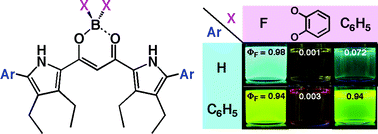Modification at a boron unit: tuning electronic and optical properties of π-conjugated acyclic anion receptors†
Abstract
Substituents at the

* Corresponding authors
a
College of Pharmaceutical Sciences, Institute of Science and Engineering, Ritsumeikan University, Kusatsu, Japan
E-mail:
maedahir@ph.ritsumei.ac.jp
Fax: +81 77 561 2659
Tel: +81 77 561 5969
b PRESTO, Japan Science and Technology Agency (JST), Kawaguchi, Japan
c Division of Medicine and Engineering Science, Interdisciplinary Graduate School of Medical and Engineering, University of Yamanashi, Kofu, Japan
Substituents at the

 Please wait while we load your content...
Something went wrong. Try again?
Please wait while we load your content...
Something went wrong. Try again?
H. Maeda, M. Takayama, K. Kobayashi and H. Shinmori, Org. Biomol. Chem., 2010, 8, 4308 DOI: 10.1039/C0OB00044B
To request permission to reproduce material from this article, please go to the Copyright Clearance Center request page.
If you are an author contributing to an RSC publication, you do not need to request permission provided correct acknowledgement is given.
If you are the author of this article, you do not need to request permission to reproduce figures and diagrams provided correct acknowledgement is given. If you want to reproduce the whole article in a third-party publication (excluding your thesis/dissertation for which permission is not required) please go to the Copyright Clearance Center request page.
Read more about how to correctly acknowledge RSC content.
 Fetching data from CrossRef.
Fetching data from CrossRef.
This may take some time to load.
Loading related content
